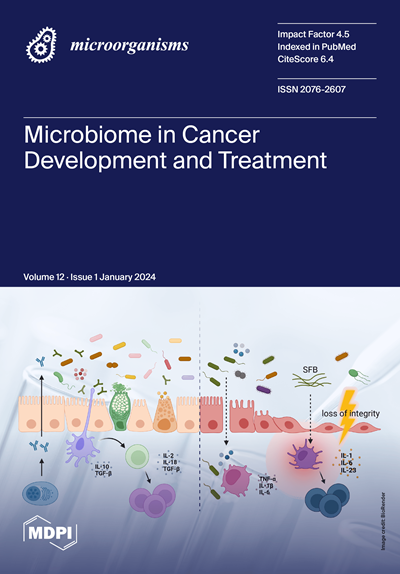Effects of 5-Aminolevulinic Acid Supplementation on Gas Production, Fermentation Characteristics, and Bacterial Community Profiles In Vitro
IF 4.2
2区 生物学
Q2 MICROBIOLOGY
引用次数: 0
Abstract
To investigate the effect of 5-aminolevulinic acid (5-ALA) on in vitro rumen gas production, fermentation characteristics, and bacterial community profiles, five levels of 5-ALA (0, 100, 500, 1000, and 5000 mg/kg DM) were supplemented into a total mixed ration (concentrate/forage = 40:60) as substrate in an in vitro experiment. Results showed that as the supplementation level of 5-ALA increased, asymptotic gas production (b) decreased linearly and quadratically (p < 0.01) while the dry matter degradation rate increased quadratically (p < 0.01). Meanwhile, the propionate concentration of 72 h incubation fluid increased linearly (p = 0.03) and pH value increased linearly and quadratically (p < 0.01), while the concentrations of butyrate, isobutyrate, valerate, isovalerate, and NH3-N and the ratio of acetate/propionate (A/P) decreased linearly and quadratically (p < 0.05). There was no significant difference in any alpha diversity indices of bacterial communities among the various 5-ALA levels (p < 0.05). PCoA and PERMANOVA analysis revealed that the bacterial profiles showed a statistical difference between the treatment 5-ALA at 1000 mg/kg DM and the other levels except for 5000 mg/kg DM (p < 0.05). Taxonomic classification revealed a total of 18 and 173 bacterial taxa at the phylum and genus level with relative abundances higher than 0.01% in at least half of the samples, respectively. LEfse analysis revealed that 19 bacterial taxa were affected by 5-ALA levels. Correlation analysis showed that Actinobacteriota was positively correlated with the gas production parameter b, the ratio of A/P, and the concentration of butyrate, isovalerate, and NH3-N (p < 0.05) and negatively correlated with pH (p < 0.05). WPS-2 exhibited a negative correlation with the gas production parameter b, the ratio of A/P, and the concentration of butyrate, valerate, isobutyrate, isovalerate, and NH3-N (p < 0.05), along with a weaker positive correlation with pH (p = 0.04). The Bacteroidales BS11 gut group was negatively correlated with the concentration of propionate but positively correlated with gas production parameter b and the concentration of butyrate and NH3-N (p < 0.05). The Lachnospiraceae NK3A20 group was found to have a positive correlation with gas production parameter b, the ratio of A/P, and the concentration of butyrate, isobutyrate, isovalerate, valerate, total VFA, and NH3-N (p < 0.05), but a highly negative correlation with pH (p < 0.01). Differential metabolic pathways analysis suggested that metabolic pathways related to crude protein utilization, such as L-glutamate degradation VIII (to propanoate), L-tryptophan degradation IX, and urea cycle, increased with 5-ALA levels. In summary, including 5-ALA in the diet might improve energy and protein utilization by reducing the abundance of Actinobacteriota, the Bacteroidales BS11 gut group, the Lachnospiraceae NK3A20 group, and certain pathogenic bacteria and increasing the abundance of WPS-2.补充 5-氨基乙酰丙酸对体外产气、发酵特性和细菌群落概况的影响
为了研究5-氨基乙酰丙酸(5-ALA)对体外瘤胃产气、发酵特性和细菌群落概况的影响,在体外实验中,将5-ALA(0、100、500、1000和5000 mg/kg DM)添加到作为底物的全混合日粮(精料/饲料=40:60)中。结果表明,随着 5-ALA 添加量的增加,渐进产气量(b)呈线性和二次下降(p < 0.01),而干物质降解率呈二次上升(p < 0.01)。同时,72 h 培养液中丙酸盐浓度呈线性增加(p = 0.03),pH 值呈线性和二次方增加(p < 0.01),而丁酸盐、异丁酸盐、戊酸盐、异戊酸盐和 NH3-N 的浓度以及乙酸盐/丙酸盐比率(A/P)呈线性和二次方降低(p < 0.05)。不同 5-ALA 水平下细菌群落的阿尔法多样性指数均无明显差异(p < 0.05)。PCoA 和 PERMANOVA 分析表明,除 5000 mg/kg DM 外,5000 mg/kg DM 的 5-ALA 处理与其他处理的细菌群落有统计学差异(p < 0.05)。分类学分类显示,在至少一半的样本中,分别有 18 个和 173 个细菌门和属分类群的相对丰度高于 0.01%。LEFSE分析显示,19个细菌类群受到5-ALA水平的影响。相关性分析表明,放线菌群与产气参数 b、A/P 比值以及丁酸盐、异戊酸盐和 NH3-N 的浓度呈正相关(p < 0.05),与 pH 呈负相关(p < 0.05)。WPS-2 与产气参数 b、A/P 比率以及丁酸盐、戊酸盐、异丁酸盐、异戊酸盐和 NH3-N 的浓度呈负相关(p < 0.05),与 pH 呈较弱的正相关(p = 0.04)。类杆菌 BS11 肠道组与丙酸盐浓度呈负相关,但与产气参数 b 以及丁酸盐和 NH3-N 浓度呈正相关(p < 0.05)。发现拉赫诺斯弧菌属 NK3A20 组与产气参数 b、A/P 比值以及丁酸盐、异丁酸盐、异戊酸盐、戊酸盐、总 VFA 和 NH3-N 的浓度呈正相关(p < 0.05),但与 pH 值呈高度负相关(p < 0.01)。差异代谢途径分析表明,与粗蛋白利用相关的代谢途径,如 L-谷氨酸降解 VIII(转化为丙酸盐)、L-色氨酸降解 IX 和尿素循环,随着 5-ALA 水平的提高而增加。总之,在日粮中添加 5-ALA 可能会通过降低放线菌、类杆菌 BS11 肠道组、漆树科 NK3A20 组和某些致病菌的丰度以及增加 WPS-2 的丰度来提高能量和蛋白质的利用率。
本文章由计算机程序翻译,如有差异,请以英文原文为准。
求助全文
约1分钟内获得全文
求助全文
来源期刊

Microorganisms
Medicine-Microbiology (medical)
CiteScore
7.40
自引率
6.70%
发文量
2168
审稿时长
20.03 days
期刊介绍:
Microorganisms (ISSN 2076-2607) is an international, peer-reviewed open access journal which provides an advanced forum for studies related to prokaryotic and eukaryotic microorganisms, viruses and prions. It publishes reviews, research papers and communications. Our aim is to encourage scientists to publish their experimental and theoretical results in as much detail as possible. There is no restriction on the length of the papers. The full experimental details must be provided so that the results can be reproduced. Electronic files and software regarding the full details of the calculation or experimental procedure, if unable to be published in a normal way, can be deposited as supplementary electronic material.
 求助内容:
求助内容: 应助结果提醒方式:
应助结果提醒方式:


